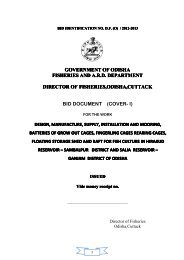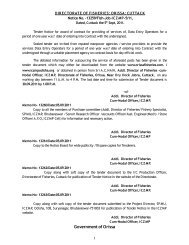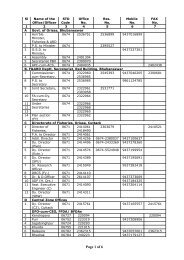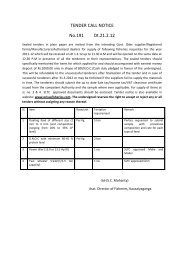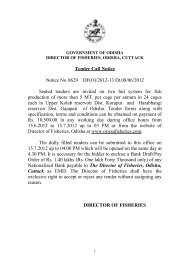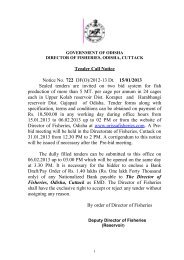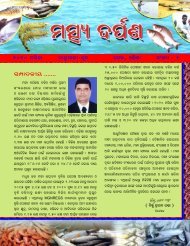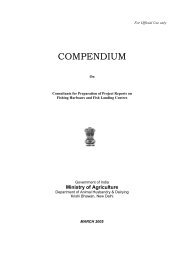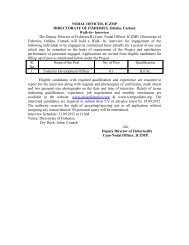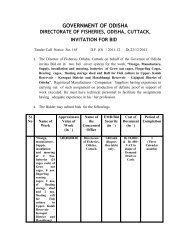Value Chain Analysis of Fishery in Puri and Ganjam District of Orissa
Value Chain Analysis of Fishery in Puri and Ganjam District of Orissa
Value Chain Analysis of Fishery in Puri and Ganjam District of Orissa
You also want an ePaper? Increase the reach of your titles
YUMPU automatically turns print PDFs into web optimized ePapers that Google loves.
Draft Report on “<strong>Fishery</strong> Supply <strong>Cha<strong>in</strong></strong>”<br />
Confidential<br />
Executive Summary<br />
NiMble system has completed the research on ““<strong>Value</strong> <strong>Cha<strong>in</strong></strong> analysis <strong>of</strong> <strong>Fishery</strong> <strong>in</strong> <strong>Puri</strong> <strong>and</strong><br />
<strong>Ganjam</strong> <strong>District</strong> <strong>of</strong> <strong>Orissa</strong>”. The study was taken up with the objective <strong>of</strong> identification <strong>of</strong> local <strong>and</strong><br />
regional market potential for each ma<strong>in</strong> species <strong>of</strong> fish commonly found <strong>in</strong> the catch <strong>of</strong> artisanal<br />
fisherfolk <strong>in</strong> <strong>Ganjam</strong> <strong>and</strong> <strong>Puri</strong> district <strong>and</strong> to provide <strong>in</strong>formation on the price <strong>of</strong> each <strong>of</strong> these fish<br />
species <strong>in</strong> local <strong>and</strong> regional markets.<br />
The study methodology <strong>in</strong>cluded both desk research <strong>and</strong> primary research <strong>in</strong> <strong>Puri</strong> <strong>and</strong> <strong>Ganjam</strong><br />
district <strong>and</strong> also <strong>in</strong> various regional markets. Various tools <strong>and</strong> technique <strong>of</strong> research <strong>in</strong>clud<strong>in</strong>g<br />
structured questionnaire, personal <strong>in</strong>terviews, group discussion, etc. were employed dur<strong>in</strong>g the<br />
primary study. A sample <strong>of</strong> 212 respondents from different sections <strong>of</strong> the fishery trade was<br />
covered <strong>in</strong> the study. The study has employed two framework viz. BCG matrix <strong>and</strong> VRIO analysis<br />
for <strong>in</strong>terpretation <strong>and</strong> underst<strong>and</strong><strong>in</strong>g <strong>of</strong> the supply cha<strong>in</strong>. Statistical analysis <strong>of</strong> the data generated<br />
from the field study was undertaken.<br />
A policy review <strong>of</strong> the central <strong>and</strong> state government perta<strong>in</strong><strong>in</strong>g to fishery has been taken up to<br />
underst<strong>and</strong> the ‘legislative or govern<strong>in</strong>g factors’ or the ‘rules <strong>of</strong> trade’. The implication <strong>and</strong> impact<br />
<strong>of</strong> the legislative policies on the trade <strong>and</strong> the various stakeholders has been analyzed.<br />
The study has developed market <strong>and</strong> product segmentation <strong>of</strong> the fishery product l<strong>in</strong>es to <strong>in</strong>duce<br />
bus<strong>in</strong>ess underst<strong>and</strong><strong>in</strong>g <strong>of</strong> the entire gamut <strong>of</strong> available products. It has listed down the<br />
characteristic <strong>of</strong> the different markets <strong>and</strong> the specific requirement <strong>of</strong> the fish species <strong>in</strong> these<br />
markets. The study has come out with the pr<strong>of</strong>itability <strong>in</strong>dex <strong>of</strong> the various species found <strong>in</strong> the<br />
catch <strong>of</strong> <strong>Puri</strong> <strong>and</strong> <strong>Ganjam</strong> artisanal fisher folk <strong>and</strong> also for the various players <strong>of</strong> the trade. The<br />
above two <strong>in</strong>formation’s, when collated together, will help to determ<strong>in</strong>e the bus<strong>in</strong>ess plann<strong>in</strong>g <strong>and</strong><br />
strategize it as per the <strong>in</strong>tervention design.<br />
The study identifies the different value cha<strong>in</strong>s present <strong>in</strong> the trade <strong>and</strong> map it for the various<br />
market <strong>and</strong> product segment. It also gives a detail description <strong>of</strong> the various players <strong>in</strong>volved, their<br />
roles <strong>and</strong> responsibilities, the cost <strong>of</strong> operation <strong>and</strong> the barriers to entry, mobility <strong>and</strong> exit at<br />
various po<strong>in</strong>ts <strong>of</strong> the value cha<strong>in</strong>.<br />
The research undertakes a bus<strong>in</strong>ess analysis to underst<strong>and</strong> the “production –distribution –<br />
consumption” complex <strong>in</strong> the new bus<strong>in</strong>ess environment <strong>of</strong> the ‘new economy’. It looks <strong>in</strong>to the<br />
<strong>in</strong>tricacies <strong>of</strong> “Primary Phase- Secondary Phase Articulation” i.e. the exist<strong>in</strong>g production <strong>and</strong><br />
<strong>in</strong>dustrial phase l<strong>in</strong>kages. It further delves upon the dynamics <strong>of</strong> the current trade issues <strong>of</strong> socio<br />
– cultural, political <strong>and</strong> economic importance. The gender concern <strong>in</strong> the trade has also been<br />
researched <strong>in</strong> light <strong>of</strong> the exist<strong>in</strong>g trade scenario.<br />
An <strong>in</strong>dicative cost <strong>of</strong> operation <strong>of</strong> the various operators based on the primary study has been<br />
developed which can act as a ready reckoner for <strong>in</strong>tervention design. The study has undertaken a<br />
“cause effect” analysis (Fish Bone <strong>Analysis</strong>) to determ<strong>in</strong>e the causes <strong>of</strong> poor livelihood <strong>of</strong> the<br />
fisher folk <strong>of</strong> <strong>Puri</strong> <strong>and</strong> <strong>Ganjam</strong> districts. Further more “VRIO” trade analysis framework has been<br />
employed to develop a broader picture <strong>in</strong> terms <strong>of</strong> present supply cha<strong>in</strong>.<br />
The important f<strong>in</strong>d<strong>in</strong>g <strong>of</strong> the research <strong>in</strong>dicates that the fishery value cha<strong>in</strong> is dom<strong>in</strong>ated by few big<br />
players viz. the export houses <strong>and</strong> big traders. Moreover, they def<strong>in</strong>e <strong>and</strong> determ<strong>in</strong>e the “rules <strong>of</strong><br />
the trade” <strong>in</strong> <strong>Puri</strong> <strong>and</strong> <strong>Ganjam</strong> district. The number <strong>of</strong> <strong>in</strong>termediaries is high <strong>and</strong> hence adds up to<br />
the cost <strong>of</strong> product without add<strong>in</strong>g much value to the value cha<strong>in</strong>. On an average 20-25% <strong>of</strong> the<br />
value <strong>of</strong> the f<strong>in</strong>al product goes back to the fishermen. The research po<strong>in</strong>ts out the presence <strong>of</strong><br />
‘patron-client relationship’ throughout the supply cha<strong>in</strong> which is prevalent <strong>in</strong> both the districts.<br />
Credit is another imped<strong>in</strong>g factor which has led to the development <strong>of</strong> this relationship, thus down<br />
siz<strong>in</strong>g the importance <strong>and</strong> control <strong>of</strong> the fisher folk on the trade. The <strong>in</strong>frastructure to support the<br />
trade is a limit<strong>in</strong>g factor <strong>in</strong> development <strong>of</strong> fishery trade.<br />
Submitted by -: NiMble System Pvt. Ltd.<br />
Submitted to -: OXFAM (India) Trust 3



